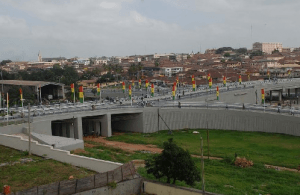Kumasi roads contractor says Ghana government owes $10m
 Workers on the reconstruction of roads in Kumasi, including the Sofoline Interchange, said they may suspend the project if government failed to reimburse funds spent for the work so far.
Workers on the reconstruction of roads in Kumasi, including the Sofoline Interchange, said they may suspend the project if government failed to reimburse funds spent for the work so far.
Mr. Eric Yang, Project Manager of the China Geo-Engineering Corporation (CGC), contractors of the project, said delays in payments for the work done was impeding the prompt completion of the project.
Speaking during a tour of the project sites by officials of the Chinese Embassy in Ghana, to highlight relations between Ghana and China, Mr. Yang said the government, the sole financiers of the project, currently owed the company about $10 million being the cost of five outstanding Interim Payment Certificates.
He explained that since 2011, the delays in payments had forced the company to suspend work for a period, every year, and had also led to increases in costs, since it had to pay the workers even though they were not working.
So far, about 75 percent of the work, worth $110 million has been completed, out of which government has paid about $90 million.
The total contract amount for the project is $150 million. The general scope of the construction work includes two interchange bridges at Sofoline and the Komfo Anokye Teaching Hospital, (KATH), the reconstruction of 11-kilometre six lane dual carriageway and drainage facilities, among other things.
According to Mr. Yang, the major part of the work done so far was on the Sofoline Interchange, which was about 85 per cent completed. However, the completed portion was in the middle of the road while the extreme ends were yet to be constructed.
He stressed that it was important for the government through the Department of Urban Roads of the Ministry of Roads and Transport, to expedite action on the release of funds for the completion of the entire project.
Mr. Yang said the company was committed to complete the project, despite the challenges, and called for the removal of properties along the site earmarked for the project.
“We want to build something that would not serve the present generation, but also for the future,” he stressed.
He added that the company was working on innovative ways of utilizing the spaces that would be created under the bridges for recreational facilities, as well as income-generating facilities like libraries that would raise funds to cater for the maintenance of the area.
Work on the project began in December 2008 instead of August 2007, owing to the revision of the initial design due to technical reasons.
The original three-year project is in its eighth year due to the challenges with funding.
Source: GNA
